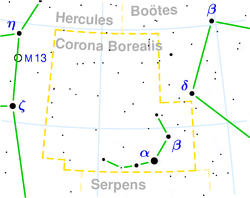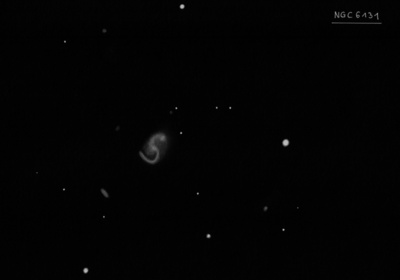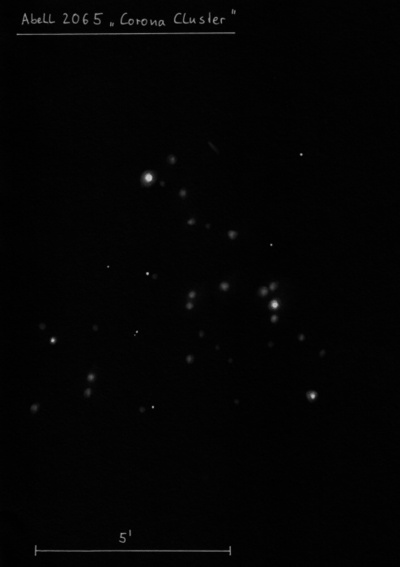A prominent small constellation of the northern sky between Hercules and Shepherd, in the direction of the elongated axis of the Big Dipper, at the junction of Vega and Arcturus. About one-third of this distance is a semicircle of seven bright stars dominated by Gemma, meaning "jewel". The Northern Crown is far from the Milky Way and so, like most constellations so placed, offers a bunch of faint galaxies. The most astronomically interesting object in the constellation is the extremely rich but trillion light-years away galaxy cluster Abell 2065 - containing more than 1,000 galaxies in the dizzying depths of space. Unfortunately, the brightest members only reach magnitude 16 and are therefore reserved for large telescopes.

T CrB - A variable star belonging to recurrent novae, located southeast of the star η CRB. Two outbursts were observed at this star. In 1866, it increased its apparent magnitude from 10.8mag to 2mag, and during the second outburst in 1946, it only reached 3mag. Currently, this star has a magnitude of only 10. The star also occasionally explodes and ejects a large amount of gas. Unlike R CRB, however, it brightens significantly with each explosion.
Gemma (α CrB) - Latin "drahokam". Occasionally, the Arabic name Alphecca (bowl) is used. The blue-white star with a magnitude of 2.3 is located 75 light-years away and is 45 times more luminous than the Sun. It cannot be observed with the naked eye, but it is an eclipsing variable star. Its brightness changes by 0.1 magnitude over a period of 17.36 days. It moves in the same direction as a group of stars mainly from the Big Dipper, known as the "bear stream". This group also includes Sirius, for example.
ζ CrB - A nice double star, even for a small telescope with an objective diameter of at least 6 cm. It consists of components with brightness of 5.1 mag and 6 mag, separated by 6.3 arcseconds. One component has a bluish tint, the other has a greenish tint. It is located at a distance of 470 light years.
ν CrB - A binary star, whose components are red giants with magnitudes of 5.2 and 5.4, can be resolved with a telescope because they have a separation of 370". They are located approximately 550 light-years away, but they do not orbit each other.
σ CrB - A binary star, with the primary component having a brightness of 5.6 magnitude, is accompanied by a 6.6 magnitude companion at a separation of 7.1 arcseconds. The companion orbits the primary star every 1,160 years. In a 100 mm telescope, we can easily distinguish the fainter and darker components.
R CrB - The main representative of the working group of variable stars, in which there are sudden drops in brightness at irregular intervals by several stellar classes. The apparent brightness of this luminous giant remains at 5.8 mag for most of the time, then drops to 13.8 mag or sometimes even to 15 mag within a few weeks and remains so for several months. The giant star ejects a huge cloud of carbon-rich gas into the surrounding area through thermonuclear reactions, which obscures the star's light and causes the sharp drop in brightness that we observe. When the cloud disperses, the star shines again with undiminished light.
NGC 6131

Édouard Stephan discovered NGC 6131 = St XII-84 on 15 Jun 1882. His position is very accurate.
400/500mm - 17.5" (6/27/87): very faint, small, round. Located 3.5' E of mag 9 SAO 65250.
Notes by Steve Gottlieb
Abell 2065

| Type | GALCL [23III] |
| RA | 15:22:06.0 |
| Dec | +27:43:00.0 |
| major_axis | 22.4' |
| mag | 15.6 |